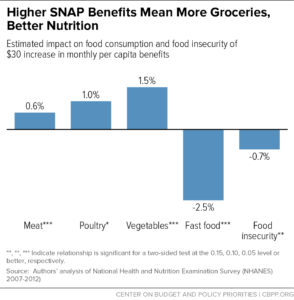A new Center on Budget and Policy Priorities (CBPP) study released last week adds to the evidence that higher Supplemental Nutrition Assistance Program (SNAP) benefits will improve the health and well-being of low-income Americans. Research previously compiled by the White House Council of Economic Advisors and FRAC shows that SNAP alleviates poverty, reduces food insecurity, improves dietary quality, protects against obesity, and improves health, especially among children. However, inadequate benefits — the most important weakness of SNAP — severely limit the program’s ability to do more to improve food security, health, and well-being.
What is the Impact of a $30-Per-Person Monthly Increase in SNAP Benefits?
In the new CBPP report, economists Patricia M. Anderson of Dartmouth College and Kristin F. Butcher of Wellesley College examined the impact of a $30-per-person increase in monthly SNAP benefits. Higher SNAP benefit levels were estimated to reduce food insecurity, increase grocery spending, improve the consumption of many nutritious foods (including vegetables and lean sources of protein), and reduce fast food consumption (see figure). These improvements in consumption are consistent with findings from in-depth interviews of SNAP participants who reported that they would buy more fruits, vegetables, and lean meat if their food budgets allowed.

What are the Impacts on Health and Well-Being When SNAP Benefits are More Adequate?
The nation ran a large natural experiment involving higher SNAP benefits several years ago, and it worked. Average benefits starting in April 2009 reflected a temporary boost in allotments pursuant to the American Recovery Reinvestment Act (ARRA) of 2009. This increase was in recognition of the effective and quick stimulative effect of SNAP benefits on the economy as well as the recognition that hard-hit families needed additional assistance. Unfortunately, the temporary ARRA boost ended on November 1, 2013, and benefits were reduced for all SNAP participants.
Research on the ARRA boost and SNAP benefit adequacy, including the new CBPP study, demonstrates favorable impacts on food security, health, dietary intake, and food spending with an increase in benefits. This selection of studies focuses on the ARRA boost:
- U.S. Department of Agriculture (USDA) researchers found that the temporary increase in SNAP benefit levels from ARRA helped reduce food insecurity by 2.2 percentage points and reduce very low food insecurity by 2.0 percentage points among low-income households between December 2008 (pre-ARRA) and December 2009 (about eight months post-ARRA). The boost also helped increase food expenditures by 5.4 percent among low-income households.
- Conversely, Children’s HealthWatch recently examined the impact on food insecurity of the post-ARRA reduction. Compared to SNAP households with young children during the SNAP benefit boost period, SNAP households with young children after the SNAP rollback were 23 percent more likely to be household food insecure and 17 percent more likely to be child food insecure.
- In Massachusetts, inpatient Medicaid cost growth significantly declined after the ARRA increase, especially among people with chronic illnesses, according to a recent study in the American Journal of Public Health. The cost declines were driven by reduced hospital admissions and, to a lesser extent, reduced length of stay per admission.
- Two years after the ARRA boost, young children in households receiving SNAP benefits were significantly more likely to be “well” than children from non-participating low-income households, according to a Children’s HealthWatch study. Such a difference was not observed prior to the benefit boost — that is, improved SNAP benefit levels positively impacted child health. (Children were classified as “well” if they were in good health per parent report, were developing normally, were not overweight or underweight, and had never been hospitalized.)
Why are SNAP Benefits Inadequate?
Researchers, advocates, and emergency food providers have been saying that SNAP benefits are inadequate for years, and in 2013, the prestigious Institute of Medicine, after a thorough study, outlined the factors that explain why the SNAP allotment is not enough to get most families through the month with a minimally adequate diet (e.g., the lag in SNAP benefits keeping up with inflation, the failure to fully account for shelter costs). An analysis by FRAC one year earlier found that SNAP benefits are inadequate, in part, because they are based on USDA’s impractical Thrifty Food Plan. The plan includes impractical lists of foods; lacks the variety called for in the Dietary Guidelines for Americans; unrealistically assumes adequate facilities and time for food preparation; unrealistically assumes food availability, affordability, and adequate transportation; particularly costs more than the SNAP allotment in many parts of the country; and ignores special dietary needs.
How do we Address SNAP Benefit Inadequacy?
FRAC supports two current legislative proposals, H.R.5215 and H.R.3657, which would replace the Thrifty Food Plan as the basis for SNAP benefits with the more appropriate Low-Cost Food Plan. This change would help make SNAP benefits more adequate. H.R.5215 also would raise the minimum SNAP benefit and remove the cap on shelter deductions, further making benefit levels more realistic for SNAP households. For more information on these bills, visit FRAC’s Legislative Action Center.
Improving SNAP benefit levels is an essential component of FRAC’s plan to end hunger, and a critical strategy for furthering SNAP’s role in improving food security, health, and well-being in the nation.


